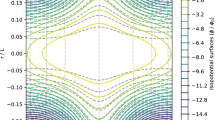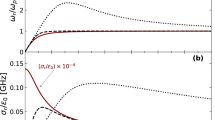Abstract
THE problems of diffusion of electromagnetic field into a conducting medium and the consequent skin-effect have been studied since the last century1. The interaction between a magnetic field and a medium of infinite conductivity, and its implications in laboratory as well as cosmological media, received considerable attention from many authors, in recent years, after the pioneering work of Alfven2, and others. Experiments, with liquid metals3 and laboratory plasmas4, have shown that a magnetic field may be frozen in a medium and that it may be trapped and compressed. The assumption of infinite conductivity requires the electric field to be zero, to avoid infinite currents. Moreover, the vast literature on the subject is mainly concerned with cosmological problems where, under usual conditions, the infinite conductivity approximation is good enough2,5. Consequently, no thought has been given, it seems, to the possibility of analogous behaviour of electric fields.
This is a preview of subscription content, access via your institution
Access options
Subscribe to this journal
Receive 51 print issues and online access
$199.00 per year
only $3.90 per issue
Buy this article
- Purchase on Springer Link
- Instant access to full article PDF
Prices may be subject to local taxes which are calculated during checkout
Similar content being viewed by others
References
Rayleigh, Lord, Phil. Mag., 21, 381 (1886).
Alfven, H., Cosmical Electrodynamics (Oxford, 1950).
Lundquist, S., Nature, 164, 145 (1949).
Bezbatchenko, A. L., et al., J. Nuclear Energy, 5, 71 (1957).
Dungey, J. W., Cosmic Electrodynamics (Cambridge, 1958).
Miller, K. W., Elect. Eng., 66, 1496 (1947).
Vallese, L. M., J. App. Phys., 25, 225 (1954).
Grumet, A., J. App. Phys., 30, 682 (1959).
Haines, M. G., Proc. Phys. Soc., 74, 576 (1959).
Cullwick, E. G., Electromagnetism and Relativity (Longmans, 1957).
Ritchmeyer, F. E., et al., Introduction to Modern Physics (McGraw-Hill, 1955).
Cowling, T. G., Magnetohydrodynamics (Interscience, 1957).
Melcher, J. R., Phys. of Fluids, 4, 1348 (1961).
Swann, W. F. G., Electromagnetic Phenomena in Cosmical Physics, edit. by Lehnert, B., 428 (Cambridge Univ. Press, 1958).
Author information
Authors and Affiliations
Rights and permissions
About this article
Cite this article
GEORGE, K. Trapping and Compressing Electric Fields. Nature 202, 380–381 (1964). https://doi.org/10.1038/202380a0
Issue Date:
DOI: https://doi.org/10.1038/202380a0
Comments
By submitting a comment you agree to abide by our Terms and Community Guidelines. If you find something abusive or that does not comply with our terms or guidelines please flag it as inappropriate.



